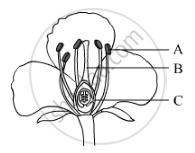Advertisements
Advertisements
Question
Draw a neat and labelled diagram.
Double fertilization in angiosperms
Solution

APPEARS IN
RELATED QUESTIONS
Name the parts A, B and C shown in the following diagram and state one function of each.

A student has to perform the experiment "To identify the different parts of an embryo of a dicot seed." Select from the following an appropriate group of seeds:
(a) Pea, gram, wheat
(b) Red kidney bean, maize, gram
(c) Maize, wheat, red kidney bean
(d) Red kidney bean, pea, gram
Answer the following question.
State significance of pollination.
Name and differentiate between the two modes of pollination in flowering plants.
Name the part made up of the stigma, style and ovary.
What is the name of female organ of a flower (other than carpel)?
Fill in the following blank with suitable word :
The ovule becomes a .......... after fertilisation.
Fill in the following blank with suitable word :
The term used to refer to the transfer of pollen from the stamen of one flower to the carpel of another flower of the same species is...........
What is seed? What are the parts of a seed? Explain with the help of a labelled diagram.
What is pollination? How does pollination occur?
Describe the process of fertilisation in a flower with the help of labelled diagrams.
(a) Draw a neat diagram of a flower showing its various parts. In this diagram mark stem, receptacle, sepals, petals, stamen and carpel.
(b) What name is given to (i) all the petals of a flower, and (ii) all the sepals of a flower?
(c) What are (i) stamen, and (ii) carpel, in a flower?
(d) What is the other name of carpel of a flower?
(e) What is the name of yellow powdery substance present in the anther of a flower?
Which of the following is the correct sequence of events of sexual reproduction in a flower?
(a) pollination, fertilisation, seed, embryo
(b) seed, embryo, fertilisation, pollination
(c) pollination, fertilisation, embryo, seed
(d) embryo, seed, pollination, fertilisation
The length of pollen tube depends on the distance between :
(a) pollen grain and upper surface of stigma
(b) pollen grain on upper surface of stigma and ovule
(c) pollen grain in anther and upper surface of stigma
(d) upper surface of stigma and lower part of style
When an insect sits on the flower of a plant then some particles A present in the top of little stalks in the flower attach to its body hair. When this insect now sits on the flower of another similar plant, then particles A attached to the hair of insect are put on the top of a flask-shaped organ at the centre of flower. The particle A grows a long tube b from the top of flask-shaped organ through which C moves down and reaches the bottom part of flask-shaped organ. Here C fuses with the nucleus of d contained in structure E. the fusion of C and D forms a new cell f which grows and develops into a seed of the plant.
(a) What are particles A? What is the process of transferring A from one flower to another flower of similar plant by the insect known as?
(b) What is the name of tube B?
(c) What is C which moves down through the tube B?
(d) Name D and E.
(e) What is F?
In what ways is fertilisation in a plant different from fertilisation in a human?
Put a tick mark (✓) against the correct alternative in the following statement
Reproductive whorls of a flower are:
What is a flower ? Draw a neat labelled diagram showing the L.S. of a typical flower.
Multiple choice question. Tick (✓) the correct choice:
The male gamete is present inside the which germinates.
- the style
- the stigma
- the anther
- the ovary
Fill in the blanks:
A carpel consists of ________ , ________ and ________.
Fill in the blanks:
A stamen consists of ______ and ________.
Draw a labelled diagram of a bisexual flower.
Give one example each of unisexual and bisexual flowers. Differentiate between the two types of pollination that occur in flowers. What happens when a pollen lands on a suitable stigma? Write about the events that occur till the seed formation in the ovary.
“Cell division is a type of reproduction in unicellular organism.” Justify.
Distinguish between unisexual and bisexual flowers giving one example of each. Draw a diagram showing process of germination of pollen grains on stigma and label the following parts:
(a) Female germ cell
(b) Male germ cell
(c) Ovary
Prepare a slogan for campaign against female foeticide.
What is pollination? Mention its types.
Match the following
| 1. | Petal | Opuntia |
| 2. | Fern | Chrysanthemum |
| 3. | Phylloclade | Attracts insect |
| 4. | Hooks | Spore |
| 5. | Sucker | Bignonia |
Identify the parts A, B, C, and D?

In which part of the flower germination of pollen grains takes place?
Which of the following is the outermost protective layer of anther?
Generally, in a pollen tube, which of the following moves to the tip of the tube?
The seed that contains the future plant is called the ______
Length of pollen tube depends on the distance between ______
Which out of the following processes does not lead to the formation of clones.
Give reason for the following:
Fertilization cannot take place in flowers if pollination does not occur.
Trace the path a male gamete takes to fertilise a female gamete after being released from the penis.
Name the reproductive parts of an angiosperm. Where are these parts located? Explain the structure of its male reproductive part.
Type of sexual reproduction is ______.
